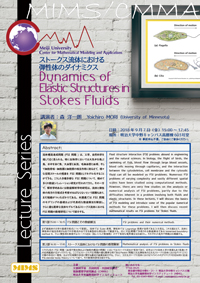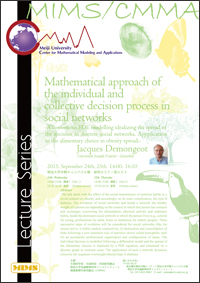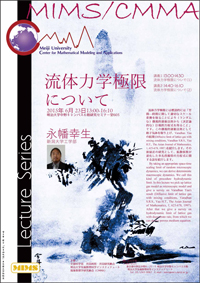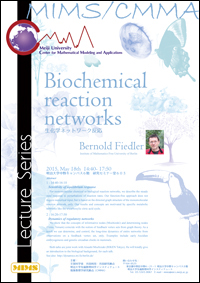- HOME
- > セミナー・イベント一覧
- > MIMS/CMMA Lecture Series
MIMS/CMMA Lecture Series
MIMS/CMMA Lecture Series
| 主催 | 共同利用・共同研究拠点 明治大学先端数理科学インスティテュート(MIMS) 「現象数理学拠点」 |
|---|---|
| 中野キャンパス へのアクセス |
|
| 中野キャンパス マップ |
第5回MIMS/CMMA Lecture Series
- 日時 :
- 2018年9月7日 15:00~17:45
- 場所 :
- 明治大学 中野キャンパス高層棟6階 研究セミナー室603
- 講師:
-
森 洋一朗 (Yoichiro MORI) 氏
ミネソタ大学 (University of Minnesota)
-
Title:
ストークス流体における弾性体のダイナミクス
Dynamics of Elastic Structures in Stokes Fluids
- Abstract:
-
流体構造連成問題(FSI問題)は、工学、自然科学を通して広く見られる。特に生物学においては大気中を飛ぶ鳥、水中を泳ぐ魚、大血管と血流、毛細血管と血球、そして細胞骨格・細胞膜と細胞質の相互作用に到るまで、様々な空間スケールの現象をFSI問題としてモデル化することができる。こうした多種多様なFSI問題について、極めて多くの数値シミュレーション研究が行われてきた。その一方で、解析学的あるいは数値解析学的研究は、流体と弾性体の両方の方程式を考察せねばならないという困難もあり、まだ端緒がついたばかりである。本講義ではFSI問題のモデリングの基礎および代表的な数値解法を解説し、さらに最も簡単な流体モデルであるストークス流体におけるFSI問題の数理研究について紹介する。
- Fluid structure interaction (FSI) problems abound in engineering and the natural sciences. In biology, the flight of birds, the swimming of fish, blood flow through large blood vessels, blood cells moving through capillaries, and the interaction between the cytoskeleton, cell membrane and the cytosolic fluid can all be modeled as FSI problems. Numerous FSI problems of varying complexity and vastly different spatial scales have been studied using computational methods. However, there are very few studies on the analysis or numerical analysis of FSI problems, partly due to the difficulties inherent in a problem involving both fluids and elastic structures. In these lectures, I will discuss the basics of FSI modeling and introduce some of the popular numerical methods for these problems. I will then discuss recent mathematical results on FSI problems for Stokes fluids.
- 第1部 15:00~16:15
FSI問題とその数値解法
FSI problems and their numerical methods -
まず連続体の力学の基礎方程式について復習し、流体ではEuler 表現、弾性体ではLagrange 表現が自然であることを見る。これを踏まえて、流体と弾性体が相互作用する系での方程式の立て方を典型的な例を用いて解説する。次にFSI 問題で多用される数値解法である immersed boundary method を、さらに慣性項を無視するストークス近似(低レイノルズ数極限)の下で有効な境界積分法を紹介し、それぞれの長所や問題点を概観する。
- I will quickly review the fundamentals of continuum mechanics. We shall see, in particular, that the Eulerian picture is more natural for the description of fluids whereas the Lagrangian picture is more natural for elastic structures. I will then discuss how to formulate the equations of fluid-structure interaction using typical examples. I will then introduce the immersed boundary method, arguably the most popular numerical method for FSI problems. I will further discuss boundary integral methods, which are useful for low Reynolds number flow, in which the inertial term can be ignored. An overview will be given of the advantages and shortcomings of these computational techniques.
- 第2部 16:30~17:45
ストークス流体におけるFSI問題の数理解析
Mathematical analysis of FSI problems in Stokes fluids -
ミクロな系のFSI問題(血球や微生物および細胞内構造の問題)においてはストークス近似が有効であり、近年はミクロ流体工学の発展もあり急激にその応用範囲が広がってきている。ここではストークスFSI問題の最も簡単な例であるPeskin 問題(1次元弾性体の2次元ストークス流体におけるダイナミクス)の解の存在と一意性、および大域解の存在に関する最近の結果を紹介する。さらに、3次元ストークス流体におけるフィラメントのダイナミクスを近似的に記述するslender body theory について述べ、その数理的研究を紹介する。
- FSI problems in microscopic systems (e.g. FSI problems involving blood cells, micro-organisms, intracellular structures, etc.) can be modeled using the Stokes approximation, and the scope of such Stokes-FSI problems is rapidly expanding due in part to the development of microfluidics. I will discuss the well-posedness and global behavior the Peskin problem (which describes the dynamics of a one-dimensional elastic string in a Stokes fluid) arguably one of the simplest Stokes-FSI problems. I will further discuss the development of a mathematical theory for slender body theory, a popular approximation used to study the dynamics of filaments in three-dimensional Stokes flow.
第4回MIMS/CMMA Lecture Series
- 日時 :
- 2018年2月16日 15:00~17:15
- 場所 :
- 明治大学 中野キャンパス高層棟6階 研究セミナー室603
- 講師:
-
Prof. Henri Berestycki
(EHESS, PSL University, Paris)
-
Title:
"Predators-prey model with competition"
Emergence of territoriality and packs in
animal behavior
- Abstract:
- In these lectures, I will present a new model that aims at showing how territories and packs are formed among certain predators. This model rests on basic principles of predators – prey interaction and competition.
- Lecture 1 15:00~16:00
- I will start by introducing the classical Lotka-Volterra model, a dynamical system describing predator – prey interaction. This simple system is one of the cornerstones of mathematical ecology. Including spatial dependence and animal movement, one is led to a system of reaction-diffusion equations. In this context, I will present recent work in collaboration with Alessandro Zilio about an extension of the original Lotka-Volterra system.
- Lecture 2 16:10~17:00
- We analyze the situation of predators like wolves that can divide up into several hostile packs. The questions we address are to understand the conditions under which predators segregate into packs, whether there is an advantage to have such hostile packs, and to compare the various territory configurations that can arise. In mathematical terms, we focus on the analysis of stationary states, stability issues, and various asymptotic behaviors of this system, especially when the competition parameter becomes unbounded.
- Discussions 17:00~17:15
第3回MIMS/CMMA Lecture Series
- 日時 :
- 2015年9月24, 25日 14:00~16:10
- 場所 :
- 明治大学 中野キャンパス高層棟6階 研究セミナー室3
- 講師:
- Prof. Jacques Demongeot
(Université Joseph Fourier - Grenoble)
-
Title:
"Mathematical approach of
the individual and collective
decision process in social networks"
-A continuous PDE modelling idealizing
the spread of the decision in discrete
social networks. Application to the alimentary
choice in obesity spread.-
- 9 /24
14:00-15:00 講義1(Part 1)
15:10-16:10 演習 (Problem session)
9 /25
14:00-15:00 講義2(Part 2)
15:10-16:10 演習 (Problem session)
- The talk deals with the effect of the social transmission of nutrition habits in a social context on obesity, and accordingly on its main complication, the type II diabetes. The evolution of social networks and inside a network the healthy weight of a person are depending on the context in which this person has contacts and exchanges concerning his alimentation, physical activity and sedentary habits, inside the dominant social network in which the person lives (e.g., scholar for young, professional for adult, home or institution for elderly people). Three successive steps of evolution will be considered for social networks (like for neural one’s): i) initial random connectivity, ii) destruction and consolidation of links following a new transition rule of nutrition choice called homophilic until iii) an asymptotic architectural organization and configuration of states. The individual decision is modelled following a differential model and the spread of the alimentary choices is idealized by a PDE equation, and simulated on a discrete graph in concrete cases. The application of such a network dynamics concerns the sequence overweight/obesity/type II diabetes.
第2回MIMS/CMMA Lecture Series
- 日時 :
- 2015年6月23日(火) 13:00~16:10
- 場所 :
- 明治大学 中野キャンパス高層棟6階 研究セミナー室3
- 講師 :
- 永幡幸生 氏
(新潟大学工学部)
Title:
流体力学極限について
- 講義1:13:00-14:30 流体力学極限について(1)
講義2:14:40-16:10 流体力学極限について(2)
流体力学極限とは標語的には「空間—時間に関して適切なスケール変換を取ることにより(ランダムな)微視的運動法則から(決定論的な)巨視的方程式を得ること」です。この微視的運動法則として格子気体を取り上げ、Varadhan Yau の結果(Diffusive limit of lattice gas with mixing conditions, Varadhan S.R.S., Yau H.T., The Asian Journal of Mathematics, 1, 623-678, 1997 )を紹介します。その後最近の研究として、拡散係数が退化した多孔質媒質の方程式に関する話を紹介します。 - By taking an appropriate space-time scaling limit of random microscopic dynamics, we can derive deterministic macroscopic dynamics. We call this kind of procedure hydrodynamic limit. In this lecture we pick up lattice gas model as microscopic model and give a survey on Varadhan Yau's result (Diffusive limit of lattice gas with mixing conditions, Varadhan S.R.S., Yau H.T., The Asian Journal of Mathematics, 1, 623-678, 1997). After that we give a survey on hydrodynamic limit of lattice gas with degenerate rate, from which we can derive porous medium equation.
第1回MIMS/CMMA Lecture Series
- 日時 :
- 2015年5月18日(月) 14:40~17:50
- 場所 :
- 明治大学 中野キャンパス高層棟6階 研究セミナー室3
- 講師:
- Prof. Bernold Fiedler
(Institute of Mathematics, Free University Berlin)
Title:
"Biochemical reaction networks"
生化学ネットワーク反応
- 1:14:40-16:10
"Sensitivity of equilibrium response"
For monomolecular chemical or biological reaction networks, we describe the steady state response to perturbations of reaction rates. Our function-free approach does not require numerical input, but is based on the directed graph structure of the monomolecular reaction network, only. Our results and concepts are motivated by specific metabolic networks like the tricarboxylic citric acid cycle. - 2:16:20-17:50
"Dynamics of regulatory networks"
We show that the concepts of informative nodes (Mochizuki) and determining nodes (Foias, Temam) coincide with the notion of feedback vertex sets from graph theory. As a result we can determine, and control, the long-time dynamics of entire networks from observations on a feedback vertex set, only. Examples include early Ascidian embryogenesis and genetic circadian clocks in mammals.
Both talks are joint work with Atsushi Mochizuki (RIKEN Tokyo). He will kindly give an introduction to the biological background, for each talk.
See also http://dynamics.mi.fu-berlin.de/












